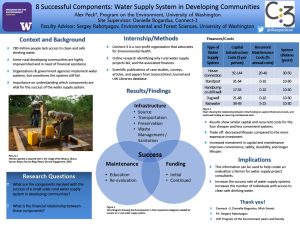Components Involved With A Successful Small-Scale Rural Water Supply System In Developing Communities
Developing communities often lack access to clean drinking water, and the population suffers from environmental health-related sicknesses. Third-party assistance is needed, and water projects are funded, but sometimes fail in the long-run. My internship at an organization called Connect-3 consisted of conducting research to this question: What are the multiple components involved with the success of small-scale rural water supply systems in developing communities? In my internship, I composed a literature review, as well as gathered evidence drawn upon resources to strengthen Connect-3’s ideals. Information was collected by researching scientific articles, journals and case studies that were published online. Additionally, information was conversed and consulted through team meetings within Connect-3. Descriptive analysis was used by absorbing and organizing the information obtained to conclude a summary of findings. The findings were sorted and organized into more general categories of funding, infrastructure, and maintenance for the purpose of clarity and organization. Additionally, in my analysis, I discuss the costs associated with the interconnection and relationship of the components. My research found eight key components for a successful rural small-scale water system: initial funding, continued funding, water source, water transportation, water preservation, waste management and sanitation, education, and routine evaluations. These findings can be used to help educate donors and increase success rates of rural water supply systems in developing areas, ultimately increasing access to clean drinking water for developing communities and bettering their quality of life.
